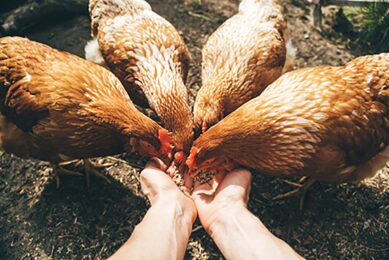Gypsum curtain ditching phosphorous runoff
An industrial byproduct can help clean up water quality in the Chesapeake Bay by trapping some agricultural pollutants in field runoff, according to a U.S. Department of Agriculture (USDA) scientist.
For years, poultry farmers on the Chesapeake Bay’s coastal plain have
amended their sandy soils with poultry manure and litter, which provides
nitrogen and phosphorus to growing crops. But phosphorus that isn’t
taken up by plants remains in the subsoil, where it leaches out into a
vast network of drainage ditches, and eventually drains into the bay
itself.
amended their sandy soils with poultry manure and litter, which provides
nitrogen and phosphorus to growing crops. But phosphorus that isn’t
taken up by plants remains in the subsoil, where it leaches out into a
vast network of drainage ditches, and eventually drains into the bay
itself.
So much phosphorus has accumulated in the regional soils that
this discharge would continue even if farmers completely stopped using
poultry manure and litter for fertilizer.
Ray Bryant is a soil scientist with the Agricultural Research Service
(ARS), USDA’s chief intramural scientific research agency. He’s
developed an innovative buffer system to mitigate this discharge by
digging an auxiliary ditch that parallels an existing draining ditch.
Then he filled the new ditch with synthetic gypsum, a byproduct produced
by the process of scrubbing sulfur from the smokestacks of coal-fired
power plants.
(ARS), USDA’s chief intramural scientific research agency. He’s
developed an innovative buffer system to mitigate this discharge by
digging an auxiliary ditch that parallels an existing draining ditch.
Then he filled the new ditch with synthetic gypsum, a byproduct produced
by the process of scrubbing sulfur from the smokestacks of coal-fired
power plants.
When the water passed out of the field and into the gypsum-filled ditch,
the soluble calcium in the gypsum “captured” the soluble phosphorus in
the water by combining with it and forming calcium phosphate. Bryant
found that the gypsum trench could treat the water draining from a field
and reduce soluble phosphorus in subsurface drainage by at least 50
percent.
the soluble calcium in the gypsum “captured” the soluble phosphorus in
the water by combining with it and forming calcium phosphate. Bryant
found that the gypsum trench could treat the water draining from a field
and reduce soluble phosphorus in subsurface drainage by at least 50
percent.
The gypsum “curtains” can last for 10 years. Then they can be excavated
and the trapped phosphorus can be used again for fertilizer. Another
bonus: Power plants don’t have to pay to haul the gypsum to a landfill.
and the trapped phosphorus can be used again for fertilizer. Another
bonus: Power plants don’t have to pay to haul the gypsum to a landfill.
These auxiliary ditches, in combination with other conservation and best
management practices, could help farmers control phosphorus leaching
without disrupting current agricultural operations.
Read more at the USDA site













